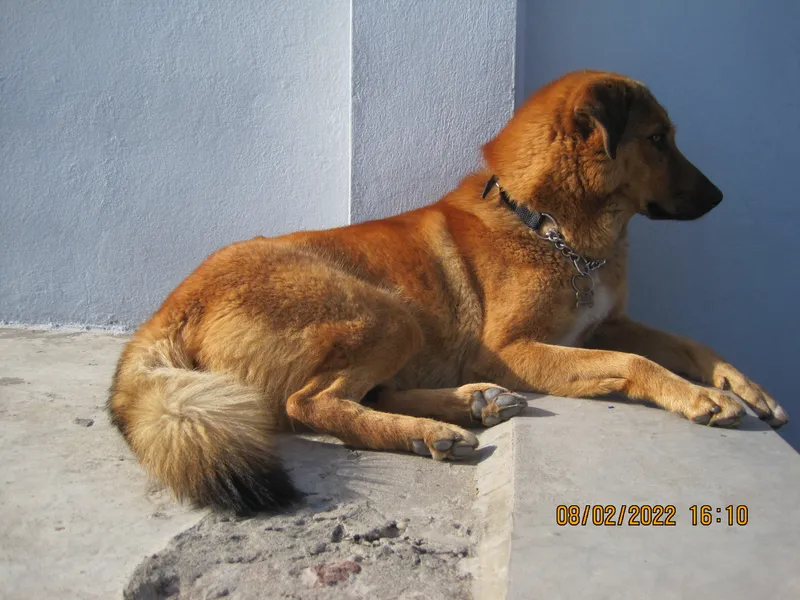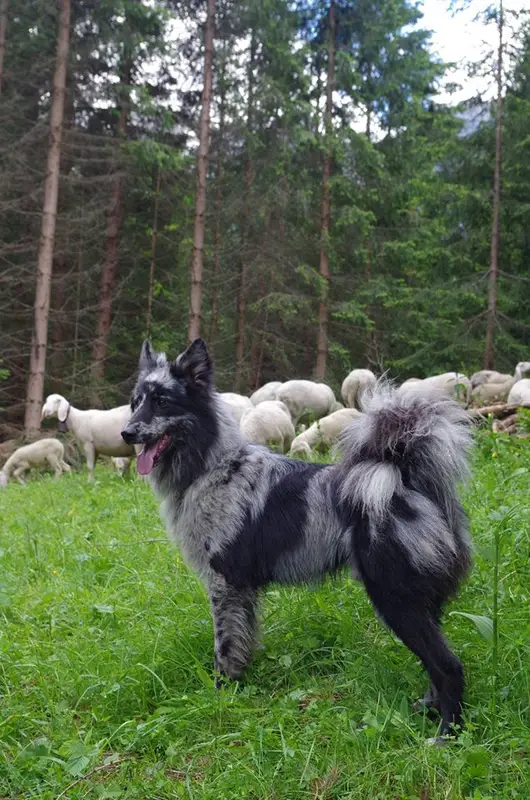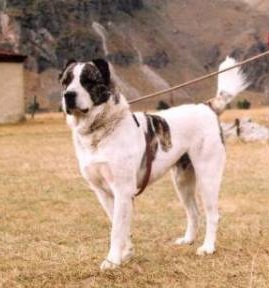Bankhar Dog
The Bankhar Dog is an ancient livestock guardian breed from Jammu and Kashmir, known for its loyalty, intelligence, and protective instincts.
Overview
🐕Breed Overview
✨Key Traits
💡What Makes Bankhar Dog Special
The Bankhar Dog is characterized by its impressive guarding abilities, loyalty, and intelligence. They are known for their bravery in protecting livestock and their families from predators.
This breed is also highly adaptable, able to thrive in various environments as long as they receive adequate exercise and mental stimulation. Their independent nature means they may not always seek human approval, but they are deeply loyal and protective of their loved ones.
Bankhar Dogs are also known for their strong territorial instincts, making them excellent watchdogs. Their unique combination of traits makes them well-suited for families who can provide them with the space and activities they need.
The Bankhar Dog, also known as the Bakharwal Dog, is a remarkable breed with deep roots in the mountainous regions of Jammu and Kashmir, India. This ancient working dog has been bred for centuries by the nomadic Bakarwal and Gujjar tribes, serving as a loyal guardian of livestock and protector of settlements. With its strong, independent nature and impressive physical capabilities, the Bankhar Dog is well-suited for the demanding role of a livestock guardian.
Historically, these dogs have played a vital role in the survival of their tribes, warding off predators like wolves and leopards while ensuring the safety of sheep and goats. Their protective instincts are matched by their intelligence and loyalty, making them not only excellent guardians but also devoted companions. However, the breed is currently facing the threat of extinction due to changing lifestyles and habitat loss, prompting urgent conservation efforts.
In terms of appearance, the Bankhar Dog is a large, robust breed with a thick coat that protects it from harsh weather conditions. Their strong build and confident demeanor reflect their working heritage. These dogs require ample exercise and mental stimulation to thrive, making them best suited for active families or individuals who can provide them with the space and activities they need.
Training a Bankhar Dog can be challenging due to their independent nature, but with consistent, positive reinforcement methods, they can learn to be well-behaved companions. Early socialization is crucial to help them become comfortable around strangers and other animals. Overall, the Bankhar Dog is a breed that embodies strength, loyalty, and resilience, making it a unique and valuable addition to any home that can meet its needs.
As efforts continue to preserve this ancient breed, potential owners are encouraged to consider adopting a Bankhar Dog to help ensure its survival for future generations.
🎉Fun Facts
The Bankhar Dog is known for its ability to fend off large predators like wolves and leopards.
The breed is facing extinction, making conservation efforts crucial for its survival.
These dogs have been used by nomadic tribes for centuries, showcasing their adaptability to harsh environments.
Breed Characteristics
Family & Friends
Good Behavior
Get Up & Go
Household Harmony
Temperament & Personality
✨Key Traits
🐕Core Temperament
The Bankhar Dog exhibits a proud and confident temperament, characterized by its loyalty and protective nature. They are intelligent and independent, often displaying a calm demeanor when not provoked.
However, they can be wary of strangers, making early socialization essential. These dogs are typically very affectionate with their families, forming strong bonds and often acting as guardians.
Their intelligence allows them to learn commands and tasks quickly, but their independent nature may lead to stubbornness during training. Overall, the Bankhar Dog is a devoted companion that thrives in an active environment where it can fulfill its natural guarding instincts.
💫Personality Profile
The Bankhar Dog is known for its strong protective instincts and loyalty to its family. They are intelligent and independent, often displaying a calm demeanor when not provoked.
However, they can be wary of strangers, making early socialization essential. These dogs are typically very affectionate with their families, forming strong bonds and often acting as guardians.
Their intelligence allows them to learn commands and tasks quickly, but their independent nature may lead to stubbornness during training. Overall, the Bankhar Dog is a devoted companion that thrives in an active environment where it can fulfill its natural guarding instincts.
🔊Vocal Tendencies
The Bankhar Dog has a moderate noise level, with a tendency to bark when they perceive a threat or when alerting their owners to potential dangers. Their deep, solid bark is characteristic of the breed and serves as an effective deterrent to intruders.
While they may bark to communicate or express excitement, they are not excessive barkers. Proper training and socialization can help manage their barking tendencies, ensuring they only vocalize when necessary.
Overall, their vocalizations are an important part of their guarding behavior, making them reliable protectors.
Affection & Social Traits
Energy & Activity
Communication Style
Care Requirements
🏃♂️Exercise Requirements
Daily Exercise
The Bankhar Dog requires a significant amount of exercise to maintain its physical and mental well-being. Ideally, this breed should engage in at least 60 to 90 minutes of vigorous activity each day. This can include long walks, running, and engaging in play that stimulates their natural guarding instincts.
Activities such as fetch, agility training, or even herding exercises can be beneficial. Puppies should start with shorter, more frequent play sessions to build stamina, while adult dogs will thrive on more intense and longer durations of exercise. Senior dogs may require less intense activities but still need regular walks to keep them healthy and engaged.
Regular exercise helps prevent obesity, reduces behavioral issues, and promotes a happy disposition. Insufficient exercise can lead to destructive behaviors, anxiety, and health problems such as joint issues or obesity.
Preferred Activities
🏠Living & Adaptability
Space Requirements
The Bankhar Dog thrives in environments that provide ample space to roam and explore. Ideally, they should have access to a large, securely fenced yard where they can run freely.
While they can adapt to living in a home with a small yard, they will require more frequent outings to satisfy their exercise needs. In urban settings, owners should ensure that they can provide sufficient daily exercise and mental stimulation.
The breed's size and energy levels mean that they are not well-suited for apartment living unless the owner is committed to providing extensive daily exercise and outdoor time. Without adequate space and exercise, Bankhar Dogs may exhibit signs of frustration or anxiety, leading to destructive behaviors.
Climate Preference
🍲Feeding Guide
Schedule
Food Types
Portion Size
Special Nutritional Needs
The Bankhar Dog requires a balanced diet rich in protein to support its active lifestyle. High-quality dog food formulated for large breeds is recommended, as it helps maintain healthy joints and muscles.
Owners should monitor for any food sensitivities and adjust the diet accordingly. Supplements such as omega fatty acids can be beneficial for coat health, while glucosamine may support joint health, especially in older dogs.
✨Grooming Requirements
Grooming Overview
The Bankhar Dog has a thick, double coat that requires regular grooming to keep it healthy and free of mats. Brushing should be done at least once a week, with more frequent grooming during shedding seasons to manage loose hair.
Use a slicker brush or a comb to remove tangles and prevent matting. Bathing should be done as needed, typically every few months, or when the dog gets particularly dirty.
Regular nail trimming and ear cleaning are also essential to maintain overall hygiene. Pay attention to dental care by brushing their teeth regularly to prevent dental issues.
Care Schedule
Brush weekly, bathe every 2-3 months, trim nails every 2-4 weeks.
Health Profile
⚕️Health Care
Regular health care is vital for the Bankhar Dog's lifespan. Routine veterinary check-ups, vaccinations, and preventive treatments are essential to catch any health issues early.
Owners should also be proactive in monitoring their dog's weight, dental health, and overall condition. Providing a balanced diet, regular exercise, and mental stimulation can significantly contribute to their well-being.
Early detection and management of health issues can lead to a longer, healthier life for the Bankhar Dog.
Health Issues Overview
⏳Average Lifespan
Genetic Factors
Genetics play a crucial role in the lifespan of the Bankhar Dog. As a breed, they may be predisposed to certain hereditary health issues, such as hip dysplasia and progressive retinal atrophy.
Responsible breeding practices that prioritize genetic diversity and health testing can help mitigate these risks. Potential owners should seek reputable breeders who conduct health screenings and provide health guarantees for their puppies.
Understanding the genetic background of the breed can help owners make informed decisions and promote a longer, healthier life for their dogs.
Living Conditions
The Bankhar Dog's lifespan can be influenced by various environmental factors, including housing conditions, climate, and social interactions. Dogs living in environments that provide ample space for exercise and mental stimulation tend to live longer, healthier lives.
Exposure to harsh weather conditions without proper shelter can negatively impact their health. Additionally, social interactions with humans and other animals can contribute to their overall happiness and well-being, potentially extending their lifespan.
Owners should ensure that their Bankhar Dog has a comfortable living environment, regular veterinary care, and opportunities for socialization.
🏥Common Health Issues
Hip Dysplasia
Warning Signs
🔬Diagnosis
Veterinarians diagnose hip dysplasia through physical examinations and X-rays.
💊Treatment
Medications, weight management, and in severe cases, surgery.
📝Management Tips
Maintain a healthy weight, provide joint supplements, and engage in low-impact exercises.
Progressive Retinal Atrophy (PRA)
Warning Signs
🔬Diagnosis
Diagnosis is typically made through an eye examination by a veterinary ophthalmologist.
💊Treatment
No cure, but supportive care can help.
📝Management Tips
Regular veterinary check-ups and monitoring for vision changes.
🛡️Preventive Care
🔬Hip Evaluation
Hip Evaluation assesses the hip joints for dysplasia and other abnormalities, crucial for large breeds prone to hip issues.
📅 Annually after 1 year of age.
🔬Eye Examination
Eye Examination checks for hereditary eye conditions, including PRA, which can affect vision in this breed.
📅 Every 1-2 years, or as recommended by a veterinarian.
Training
🧠Intelligence & Trainability
💪Work Drive
The Bankhar Dog has a strong work drive, stemming from its historical role as a livestock guardian. This breed thrives when given tasks to perform, whether it be guarding livestock, patrolling property, or engaging in interactive play.
Providing mental stimulation through training exercises, agility courses, or herding activities is essential for their well-being. Without sufficient mental and physical challenges, Bankhar Dogs may become bored and exhibit undesirable behaviors.
Engaging them in activities that align with their natural instincts will help fulfill their need for purpose and keep them happy.
⚠️Training Considerations
The Bankhar Dog can exhibit behavioral challenges, particularly if not properly socialized from a young age. Due to their strong guarding instincts, they may be wary of strangers and exhibit protective behaviors that can lead to aggression if not managed.
Early socialization with various people, animals, and environments is essential to mitigate these tendencies. Additionally, their independent nature may make training a challenge, as they can be stubborn and may not always respond to commands as eagerly as more eager-to-please breeds.
Consistent, positive reinforcement training methods are recommended to encourage desired behaviors and strengthen the bond between the dog and its owner.
📝Training Tips
Training a Bankhar Dog requires patience, consistency, and a firm yet gentle approach. Start with basic obedience training, using positive reinforcement techniques such as treats and praise to reward good behavior.
Socialization is crucial; expose your dog to different environments, people, and other animals to help them become well-rounded. Incorporate mental stimulation activities, such as puzzle toys or scent work, to keep their minds engaged.
Given their independent nature, training sessions should be kept short and engaging to maintain their interest. Establishing a routine can also help the dog understand expectations and reduce anxiety.
History & Heritage
📜Origin Story
The Bankhar Dog originated in the rugged terrains of Jammu and Kashmir, where it was bred by the nomadic Bakarwal and Gujjar tribes. These tribes relied heavily on livestock for their livelihood, and the Bankhar Dog was essential in protecting their herds from predators.
The breed's history is intertwined with the cultural practices of these communities, who have used the dogs for centuries as both guardians and companions. As the tribes migrated with their flocks across the mountainous landscape, the Bankhar Dog adapted to various environments, showcasing its resilience and versatility.
However, as modern lifestyles have encroached upon traditional practices, the breed has faced significant threats, leading to its current endangered status.
⏳Development History
The Bankhar Dog's development can be traced back several centuries, primarily in the mountainous regions of Jammu and Kashmir. Bred by the Bakarwal and Gujjar tribes, these dogs were specifically selected for their ability to guard livestock and protect settlements from predators.
Over time, the breed has adapted to the harsh climatic conditions of the region, developing a robust physique and a thick coat to withstand cold temperatures. The breed's characteristics have been shaped by its working environment, leading to a strong, independent, and intelligent dog that is highly valued by its owners.
Despite its historical significance, the breed has faced challenges in recent years due to modernization and a decline in traditional pastoral lifestyles, leading to concerns about its survival.
🛡️Purpose & Historical Role
Historically, the Bankhar Dog served as a livestock guardian, protecting sheep and goats from predators such as wolves and leopards. Its role was crucial in ensuring the safety of the herds, allowing the nomadic tribes to maintain their way of life.
The breed's protective instincts and loyalty made it an invaluable asset to the Bakarwal and Gujjar tribes, who relied on these dogs for both security and companionship. In addition to guarding livestock, the Bankhar Dog also played a role in the cultural identity of these communities, symbolizing their connection to the land and their traditional practices.
🏺Cultural Significance
The Bankhar Dog holds significant cultural importance in the Jammu and Kashmir region of India, where it has been an integral part of the nomadic Bakarwal and Gujjar tribes for centuries. These dogs are revered for their loyalty and protective instincts, serving as guardians of livestock against predators such as wolves and leopards.
Their role extends beyond mere protection; they are also companions to the nomadic tribes, helping to maintain the livelihood of these communities. The breed's historical significance is underscored by its deep-rooted connection to the region's pastoral lifestyle, making it a symbol of cultural heritage.
Unfortunately, due to changing lifestyles and habitat loss, the Bankhar Dog is now facing the threat of extinction, prompting conservation efforts to preserve this ancient breed.
Conservation Status
This breed is endangered with low population numbers globally.









